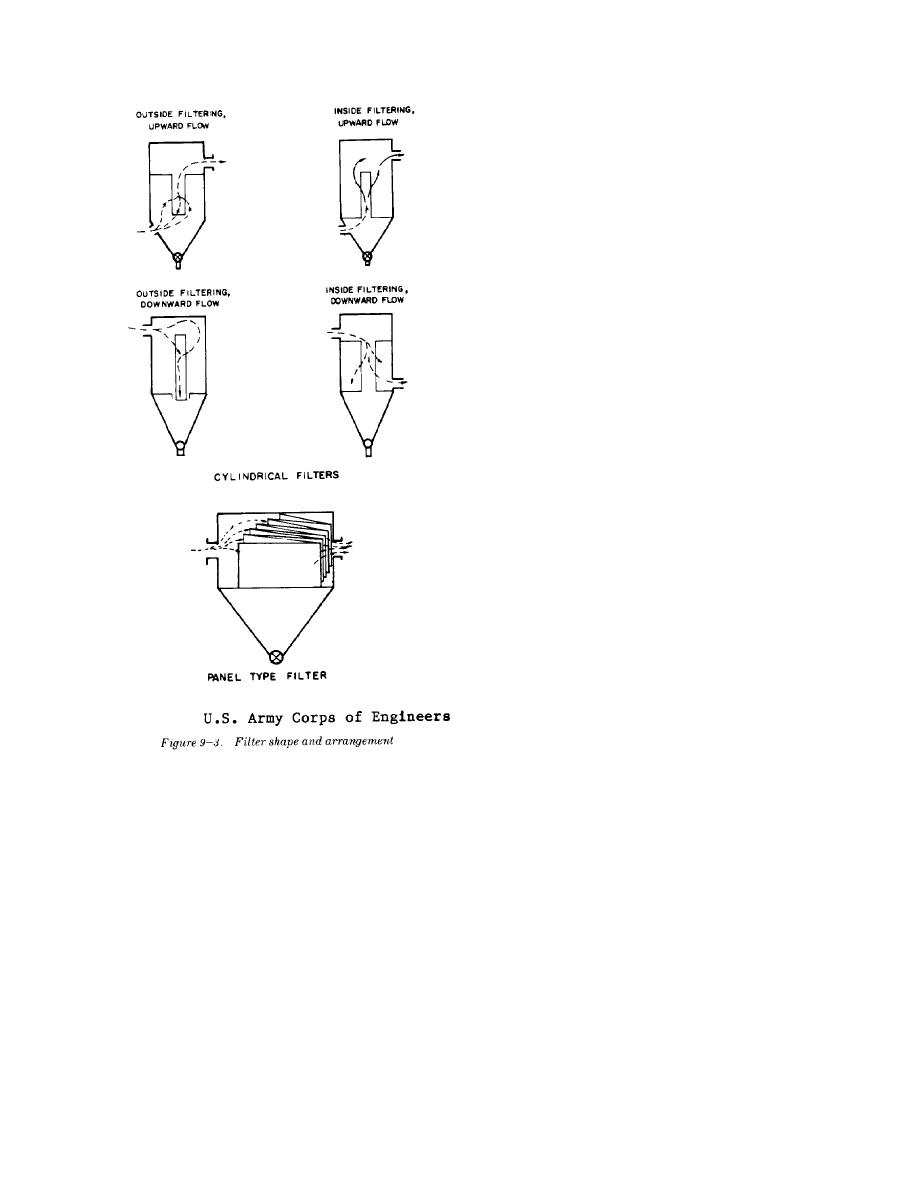
TM 5-815-1/AFR 19-6
a. Fabric type. The two basic types of fabric used in
filtration are woven and felted. The woven fabric acts
as a support on which a layer of dust is collected which
forms a microporous layer and removes particles from
the gas stream efficiently. A felted material consists of
a matrix of closely spaced fibers which collect particles
within its structure, and also utilizes the filter cake for
further sieving. Filtering velocities for woven fabrics
are generally lower than felts because of the necessity
of rebuilding the cake media after each cleaning cycle.
It is necessary that woven fabrics not be overcleaned,
as this will eliminate the residual dust accumulation
that insures rapid formation of the filter cake and high
collection efficiencies. Felts operate with less filter
cake. This necessitates more frequent cleaning with a
higher cleaning energy applied. Woven products, usu-
ally more flexible than felts, may be shaken or flexed
for cleaning. Felts are usually back-washed with higher
pressure differential air and are mainly used in pulse-
jet baghouses. However, felted bags do not function
well in the collection of fines because the very fine
particles become embedded in the felt and are difficult
to remove in the cleaning cycle.
b. Fiber. The basic structural unit of cloth is the
single fiber. Fiber must be selected to operate satisfac-
torily in the temperature and chemical environment of
the gas being cleaned. Fiber strength and abrasion
resistance are also necessary for extended filter life.
The first materials used in fabric collectors were natu-
ral fibers such as cotton and wool. Those fibers have
limited maximum operating temperatures (approx-
imately 200 degrees Fahrenheit) and are susceptible to
degradation from abrasion and acid condensation.
Although natural fibers are still used for many applica-
tions, synthetic fibers such as acrylics, nylons, and
Teflon have been increasingly applied because of their
superior resistance to high temperatures and chemical
attack (table 9-2).
(1) Acrylics offer a good combination of abrasion
baghouses are used when dust concentrations
resistance and resistance to heat degradation
are high and continuous filtering is needed.
under both wet and dry conditions. An out-
standing characteristic of acrylics is the ability
9-3.
Fabric characteristics and selection
to withstand a hot acid environment, making
them a good choice in the filtration of high
Fabric filter performance depends greatly upon the
sulfur-content exhaust gases.
correct selection of a fabric. A fabric must be able to
(2) An outstanding nylon fiber available for
efficiently collect a specific dust, be compatible with
fabric filters is Nomen, a proprietary fiber
the gas medium flowing through it, and be able to
developed by Dupont for applications
release the dust easily when cleaned. Fiber, yarn
requiring good dimensional stability and heat
structure, and other fabric parameters will affect fabric
resistance. Nomen nylon does not melt, but
performance. At the present time, the prediction of
degrades rapidly in temperatures above 700
fabric pressure drop, collection efficiency, and fabric
degrees Fahrenheit. Its effective operating
life is determined from past performance. It is
limit is 450 degrees Fahrenheit. When in
generally accepted practice to rely on the experience of
contact with steam or with small amounts of
the manufacturer in selecting a fabric for a specific
water vapor at elevated temperatures, Nomen
condition. However, the important fabric parameters
exhibits a progressive loss of strength.
are defined below to aid the user in understanding the
However, it withstands these conditions better
significance of the fabric media in filtration.
9-4


 Previous Page
Previous Page
